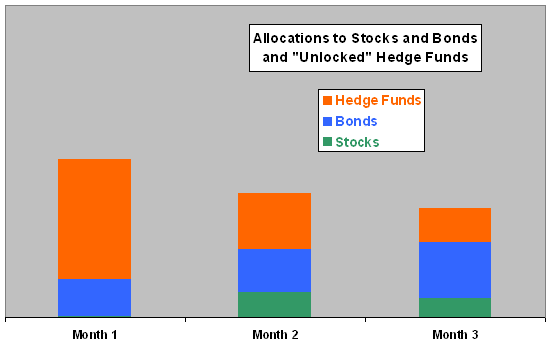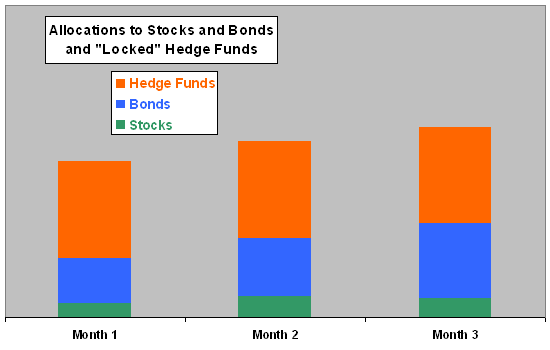Should hedge fund investors worry about withdrawal restrictions (lockup period, redemption notice period and redemption frequency constraint)? In the November 2009 update of their paper entitled “Being Locked Up Hurts”, Frans de Roon, Jinqiang Guo, and Jenke ter Horst apply Modern Portfolio Theory to model optimal asset allocations for an investor choosing among the risk-free asset (1-month Treasury bill), stocks (value-weighted NYSE equity index), bonds (Fama Bond Portfolio) and a fund of hedge funds (HFRI Fund of Funds composite index) with and without a withdrawal restriction (lockup) period. The essential assumption is that the portfolio efficiency goal requires rebalancing at an interval shorter than the lockup period (in the study, one month versus three months). Using data spanning January 1990 through December 2007 (18 years), limited by hedge fund data availability, they conclude that:
- U.S. single-strategy and single-manager hedge funds typically impose a one-year lockup period plus a redemption notice period ranging from one to three months, while the median lockup period for funds of hedge funds is about three months.
- Over the entire sample period, average returns (return volatilities) are:
- 11.4% (12.6%) for stocks.
- 8.5% (7.9%) for bonds.
- 9.67% (5.46%) for the HFRI Fund of Funds composite index, unadjusted for stale pricing.
- During this period, adding funds of hedge funds to a portfolio of stocks and bonds improves investment outcomes, but a hedge fund lockup period reduces the benefit. Sharpe ratios based on modeled assumptions are:
- 0.91 for stocks and bonds only.
- 1.22 for stocks, bonds and funds of hedge funds with a three-month lockup period.
- 1.53 for stocks, bonds and funds of hedge funds with no lockup period.
- Without (with) a lockup period, an optimizing investor pursues a more conservative (aggressive) portfolio strategy as the investment horizon nears. (See the charts below.)
- Results are robust to adjustment for stale pricing of hedge funds, use of the equity market dividend-price ratio to time stocks and peculiarities of hedge fund return distributions.
The following two charts, constructed from data in the paper, compare optimal monthly allocations to stocks, bonds and funds of hedge funds (unadjusted for stale pricing) for a 3-month investment horizon, without and with a 3-month lockup period for the hedge funds. Analysis shows that the optimal portfolio with unlocked (locked) hedge funds becomes more conservative (aggressive) as the investment horizon nears.


In summary, empirical analysis indicates that ignoring hedge fund withdrawal restrictions may result in material overestimation of the benefits of including hedge funds in a portfolio.
A broader message is that asset liquidity has important implications for asset allocation.